Discover the fascinating history of the University of Edinburgh, founded in 1583, and the sixth oldest university in the English-speaking world.
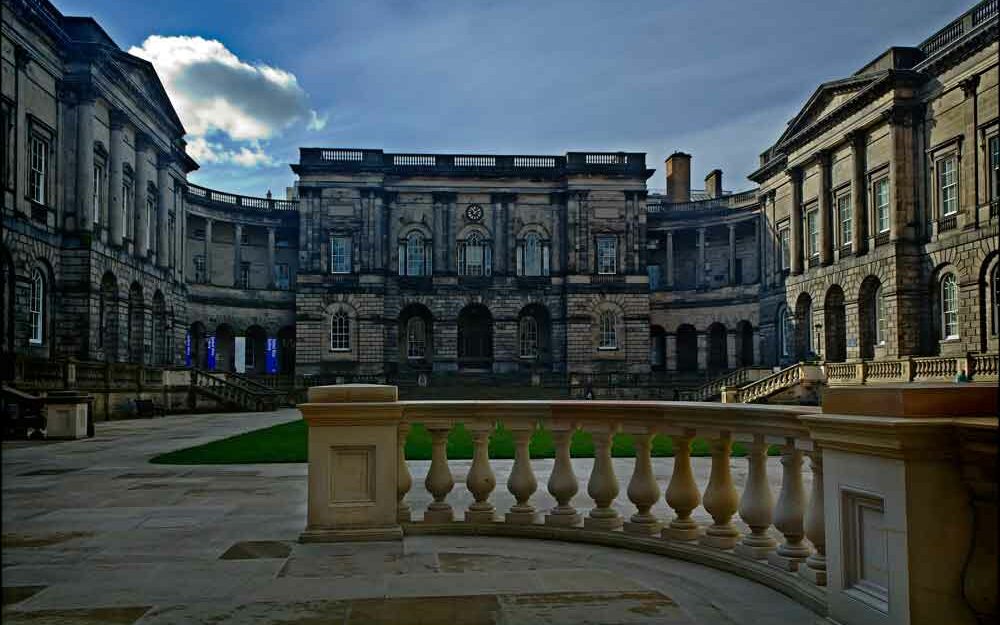
Follow Edinburgh University’s journey from ‘Tounis College’ to the world-class institution it is today.
It was often a lively one as it navigated its way through the stormy waters of Scotland’s political, religious and social evolution.
The institution, which is now over 400 years old, consists of three colleges that collectively host 20 schools.
With sub-units, centres, institutes, support services, associated staff, students, distinguished alumni and you have a vast legacy to explore.
However, given the chance to cherry-pick, there are some intriguing historical tidbits to reflect on and fascinating characters to meet and earmark for further research.
It could be argued that the first tentative steps on this academic passage began with the death of Robert Reid.
He was an interesting figure who stirred mixed emotions; John Knox certainly painted an unflattering picture of him, while George Buchanan, one of Scotland’s finest Reformation scholars, praised his virtue and charity.
Witnesses to the marriage of Mary Queen of Scots
Reid was a firm favourite of James V and became Bishop of Orkney in 1541.
In 1558 he travelled to Paris as one of the witnesses to the marriage of Mary Queen of Scots to the Dauphin of France. Shortly after, on his journey home, he died.
Reid’s will “included a bequest of funds to establish a college of higher learning which would later lead to the foundation of the University of Edinburgh in 1583.”
This modern summary, written by the university, is interesting in that it styled the new institution as a university and not a college.
Of course, it may just be a matter of semantics but the college or university question has created some considerable debate.
The most authoritative history of the University of Edinburgh.
Sir Alexander Grant (1826-1884) The Story of the University of Edinburgh during its First Three Hundred Years, a publication which today’s university said is, “still the most authoritative history of the University of Edinburgh.”
However, it rather muddies the waters by declaring that the university status came much later than 1583.
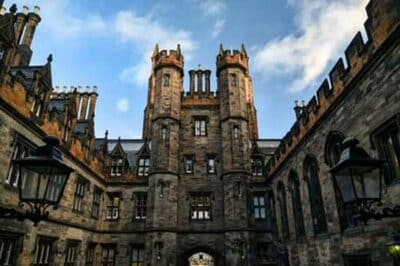
In support of his argument that Reid’s bequeath was designed not to fund a university but a college in arts and law, Grant said, “Sufficient obscurity hangs over the steps which led to the origination of the University of Edinburgh to have left room for the play of fancy…”
Putting aside the question of college or university for the moment, progress to establishing this new centre of learning was painfully slow.
It wasn’t, for example, until 1562, two years after the Scottish Reformation, that Edinburgh Town Council petitioned Mary Queen of Scots to give them the site of the former Collegiate Church of Mary-in-the-Fields, known locally as Kirk o’ Field.
The history of the University of Edinburgh and the Rough Wooing period
Much of the site had been badly damaged during the Rough Wooing period of 1544-47 and later during the Reformation.
The church and other buildings, including the associated hospital, were subsequently demolished to be replaced with Hamilton House, a home built for James Hamilton, 2nd Earl of Arran.
Arran was Regent of Scotland during the infancy of Mary Stuart.
Of course, Kirk o’ Field was also the location of the murder in February 1567, of the queen’s second husband Lord Darnley.
By all accounts, Mary’s reaction to the council’s request was lukewarm as she was only prepared to give some vague promises of future action.
Why after all would she want a Protestant college established at the heart of her capital city?
Interestingly the petition also carried a request, which she granted, to use the yards of Blackfriars Church as a burial ground.
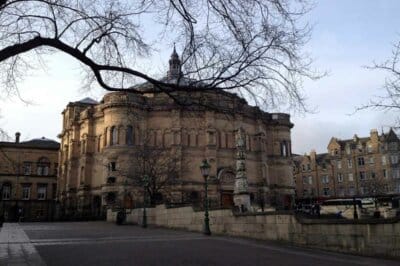
Eventually, in April 1582, the Charter of Confirmation and Novodamus was signed by the young James VI/I who declared “I will be godfather to the College of Edinburgh.”
The charter finally led to the opening of the Tounis College in October of the following year.
The main college building was Hamilton House which by this time had been seized on the forfeiture of the Hamiltons and sold. It was later acquired by the town council.
The building was refurbished and adapted, with new classrooms, hall and sleeping quarters for students. It opened on 14 October 1583.
Its first Regent, Principal and later Professor of Theology was Robert Rollock a Church of Scotland minister and in 1597 the Moderator of the General Assembly.
The regenting system
Rollock took full responsibility for the first-year class using the regenting system, practised in Scotland since the Middle Ages,
The system was designed to allow one teacher to take the class, in all subjects, through the full four-year Master of Arts degree.
There were many notable events over the following years but 1667 was a particular milestone.
During that year, Sir Andrew Balfour and Sir Robert Sibbald, by establishing a small garden to supply plants for medicinal use, took the first steps that would ultimately lead to a Faculty of Medicine.
That fledgling garden grew to become Edinburgh’s Royal Botanic Garden a world-famous centre for the study of plants, their diversity and conservation.
While both men were highly respected, Sibbald, as one of the founders of the Royal College of Physicians, Geographer of Scotland and physician to Charles II was especially important.
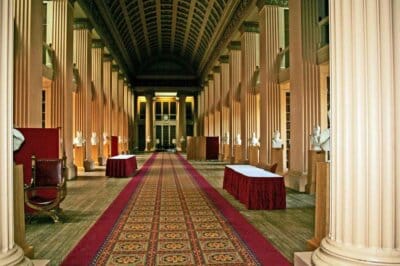
By the end of the 18th century, the university’s medical school, established in 1726, had risen to a place of prominence in Europe. It had developed along the lines of the school in Leiden, Holland .
Much of the credit for that must go to Alexander Munro, Professor of Anatomy from 1720 until 1758 and the visionary George Drummond, Lord Provost of Edinburgh six times between 1725 and 1764.
Drummond was, in the words of one scholar, “The greatest benefactor which the university ever had…”
At this stage, there were now more chairs in medicine than theology.
Historian Tom Devine wryly commented that it (the number of chairs in medicine) was a…
“telling illustration of the new interest in Man rather than God.”
Tom Devine
It’s difficult to mention the medical school without highlighting the work of William Cullen, one of the school’s greatest teachers. Cullen was appointed Professor of Chemistry and Medicine in 1755.
Transition from college to university
The early part of the 18th century was recognised as a seminal period after William Carstares, the principal between 1703 and 1715, introduced sweeping reforms.
His appointment brings us back to the question of college or university.
It was Alexander Grant who said the changes Carstares introduced marked the transition from college to university.
He was already a prominent figure in the world of Scottish politics and religion, studying for a Bachelor of Arts at Edinburgh before taking theology at Utrecht, Holland.
He became an advisor to William of Orange, later King William II of Scotland (III of England).
However, his early relationship with the Stadtholder of the Dutch Republic was seen as a challenge to Charles II and as a consequence, he spent time in prison.
At one point he was tortured for information relating to the Rye House Plot of 1674, a scheme to assassinate Charles.
Related Content
Influenced by the Dutch methods of teaching, Carstares swept away the inefficient regenting system and introduced professorships for each subject on the curriculum.
On his watch, the Faculties of Arts and Law were established and new chairs were established in Public Law, Civil Law, Anatomy and Chemistry.
His work and that of William Wishart and George Drummond who followed turned the university into an organisation that we would recognise today.
Following the South Bridge Act of 1785 which fundamentally altered the layout of the Old Town, the town council took the opportunity to draw up plans for what is now the Old College, .
Designed by the celebrated Scottish architect Robert Adam, a former Edinburgh student, the foundation stone for the Old College, one of the city’s most beautiful buildings, was laid in 1789.
The work was finally completed after his death by William Playfair another Edinburgh student.
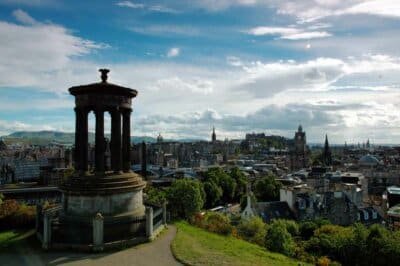
Arguably the jewel in the Old College crown is Playfair’s library. At 190 feet long with a vaulted ceiling and classical columns is one of the finest interiors in the city. Today it’s not used as a library but as the venue for more formal occasions
Playfair later designed some of the capital’s most recognisable buildings, among them the Royal College of Surgeons, the National Gallery on the Mound and Calton Hill, the National Monument.
Flodden Wall
In 2010, an archaeological desk-based assessment was carried out in the Old College quadrangle before a major renovation project. It produced some fascinating results.
It looked first at the history of the area, reminding us that the Old College was built on the original Hamilton House.
The site, which stood inside the line of the defensive Flodden Wall, was built after the Scots defeat at the Battle of Flodden in 1513.
Further archaeological work the following year, which appropriately enough was the International Year of Chemistry, uncovered chemicals and laboratory equipment.
Almost certainly the equipment belonged to Joseph Black, one of Scotland’s greatest Enlightenment figures.
Black was Professor of Chemistry at the university and the discoverer of carbon dioxide gas.
In 1749, John Moultrie, a medical student born in South Carolina to a Scottish father, was the first American born to graduate. His thesis on yellow fever was recognised as the most authoritative of its time.
Later graduates from the United States included Samuel Baird (1742-1821) founder of the New York Medical School, Benjamin Rush, (1746-1813) signatory of the Declaration of Independence and Benjamin Waterhouse (1754-1846) co-founder of Harvard Medical School.
Edinburgh University alumni
Since then many more Americans, British and countless other nationalities have graduated from the university.
Among the most notable is David Hume, a writer, philosopher, religious sceptic and a towering figure of the Scottish Enlightenment.
Robert Louis Stevenson, who delighted readers with tales of Treasure Island and Kidnapped, was also a student.
In addition, Charles Darwin, who contributed so much to the science of evolution and Dugald Stewart, like Hume, a philosopher and also a Professor of Mathematics at Edinburgh.
Also what writer today isn’t grateful to Peter Mark Roget who wrote that indispensable thesaurus.
The biographer of David Hume Roderick Graham whose writing gives a real insight into university life, argued that Edinburgh, like other Scottish universities, appealed to international students.
It seems that they did not insist that prospective students swore allegiance to Protestantism, a prerequisite for Oxford and Cambridge Universities.
Graham also suggested that another reason for its popularity was that by this time most of the students lived outside the university campus, “in the town with its attendant pleasures of drink and female company.”
Bonnie Prince Charlie
In mid-September 1745 the army of Charles Edward Stewart entered Edinburgh, occupying the city until early November. The university’s staff, students and some alumni, on behalf of the Hanoverian government, formed a company to defend the city.
Throughout the Jacobite occupation, normal university life ceased.
Minutes of the Senatus Academicus, the senior university body, didn’t record any meeting between 18 June 1745 and 12 December 1746 and no graduations were recorded for 1746.
Today the university has hundreds of buildings scattered throughout the city and beyond and while each is an essential cog in the wheel there are a few that are particularly important. In addition to the Old College there is, almost inevitably, the New College.
Edinburgh University’s majestic New College was founded in 1846 after the Disruption, a schism in the Church of Scotland.
This saw almost a third of ministers and a large proportion of the laity break away from what they regarded as state control, to form the Free Church of Scotland under the direction of Thomas Chalmers.
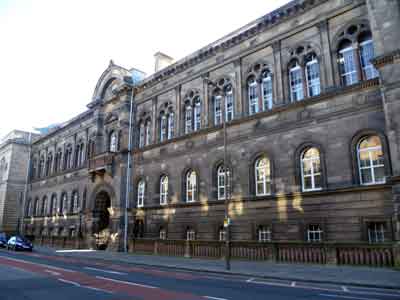
Chalmers became Principal and Professor of Divinity and David Welsh took the post of Professor of Divinity and Church History.
Eventually, the Reunification of the Church of Scotland in 1929 and the Universities (Scotland) Act 1932 started the process which culminated with, in 1937, an expanded Faculty of Divinity.
Within New College is the General Assembly Hall, home to the annual General Assembly of the Church of Scotland.
In May 1999, this versatile hall became the temporary home (before Holyrood) of the Scottish Parliament. Who can forget that announcement from Dr Winnie Ewing as she told the world “The Scottish Parliament which adjourned on 25 March 1707 is hereby reconvened.”
The Universities (Scotland) Act 1858 allowed control to move from Edinburgh Town Council to the university.
The office of chancellor was created, as was a university court chaired by the rector (elected by the students).
Significantly the act removed the need for the principal to be a minister of the Church of Scotland.
Over the centuries, many have played a fundamental part in the growth of this great institution.
A few are mentioned here but sadly many others remain in the shadows, visible only to the determined researcher.
They are important, not only because they contributed to the development of Edinburgh University, but in doing so they also contributed to the development of their country.
The first women on a degree course
This seems like a good point to mention seven people who changed the university forever.
Now known as the Edinburgh Seven, they were a group of young women who matriculated to study medicine in 1869.
They were the first women admitted to a degree program at any British university. A plaque outside Surgeons’ Hall reminds us of this important moment in time.
Returning, for a final time, to the founding of Edinburgh’s Tounis College, Sir Alexander Grant is clear that credit for the college should go to the “Town Council and the Ministers of the City.”
Some years later historian Bruce Lenman, acknowledging the importance of the city’s role, said, “There was a complete alliance in Edinburgh between city and university. They were interdependent.” There are others too who came to the same conclusion.